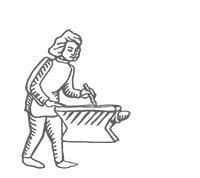|
J. D. Bos an essay on visiting the Museum of Russian Icons [ Part 1 | Part 2 | Part 3 | Part 4 | photo gallery] [ continued ] The audio tour focuses mostly on the story of the saints in the icons, rather than on the material or artisanal aspects of the icon itself. This strikes me as oddly in keeping with the original function of icons: firstly, to inspire reverence-here, the awe is secular, in the form of the art-experience-and secondly, to serve as hagiographic textbooks for the lives of the saints. I consider how different the emphasis can be in those larger museums where visitors flock to works by the most well-known artists, less often stopping by to check out the work of lesser-known creators-let alone the unsigned icons of unnamed monks! But then, a key selling point of mainstream art is the recognizable style of the artist: the thick strokes of Van Gogh, the subtle detailing in Rembrandt, the sensual primitivism of Gauguin. A culture that venerates the easy-to-appreciate flair of individual genius is necessarily less inclined to celebrate an archly conservative tradition like that of Russian icon-painting. These portraits of saints and angels are achievements in a received and perfected tradition, rather than feats of cosmopolitan creativity. Indeed, the monks who painted them were called "writers," since their painting was only an extension of the traditional monkish practice of copying the Gospels by hand. In such work, innovation can be a form of blasphemy. Mindful of blasphemy, the icon-makers respected various taboos on names. It wasn't until the 1400s that the Orthodox church let painters depict God the Father. Before then, they were only permitted to paint the hand of God, or Christ the Son. You would not call Mary "the Mother of God", since this would detract from the central holiness of Christ as God. So she is simply Mary, or Saint Mary. Often the icons would be enriched with basma oklad , coverings made of brass or repoussé silver and ornamented with glass beads or jewels. Naturally enough, this treasure attracted the interest of thieves who being Christians believed the faces were real in a spiritual sense. For that reason, before cutting off the precious metals and gems, they would slash through the painted eyes, eliminating the witness to their crime. A bride's first dowry was often an icon of Mary, with a particularly expensive covering. * * * |
ISSN 2150-6795 |




